 Ian Duncan The site BFC will develop, 11-17 Second Avenue – the current home of Mars Bar – is squeezed in among the much larger Avalon Bowery Place development
Ian Duncan The site BFC will develop, 11-17 Second Avenue – the current home of Mars Bar – is squeezed in among the much larger Avalon Bowery Place developmentFor Donald Capoccia, the developer behind 11-17 Second Avenue — the new apartment complex to be built on the current site of Mars Bar — the project is a return, after a decade away, to the East Village — the neighborhood where he launched his career and where he left his mark during the gentrification of the late 1990’s.
BFC Partners, Mr. Capoccia’s company, was responsible for the construction of hundreds of units of affordable housing in the East Village at a time when property values in the area were taking off. But the firm also became mired in a bitter dispute with residents over the destruction of community gardens to make way for Eastville Gardens, a mixed income development on Avenue C between East Seventh and East Eighth Streets.
Despite some rumblings over the loss of Mars Bar, a relic of the rough-and-tumble East Village of the 1980’s, the reception for the current project could hardly have been more different. In the past decade, the neighborhood has changed dramatically: when the 12-story building rises, it will stand among the much larger Avalon development on East Houston and Bowery. So far, BFC’s plan is going smoothly and Mr. Capoccia stands by his record.
“Housing production of that type in a neighborhood that was changing so rapidly is a great asset,” Mr. Capoccia said in a recent interview. Referring to low-income owners of units at the co-op he added, “community gardens are also a good asset but what was going on in the East Village then and where we are today, clearly a lot of these people wouldn’t be able to afford to live in the neighborhood.”
Read more…
In 11 days, changes in the laws that regulate how much your landlord can charge in rent per month will begin to take effect.
However, the changes are not exactly what local tenant advocacy groups wanted. Many groups, including the Cooper Square Committee, Real Rent Reform, Tenants and Neighbors and the Good Old Lower East Side were hoping state legislators would eliminate the rent laws’ vacancy decontrol, which allows a landlord who renovates a unit to charge more in rent per month to a new tenant after the previous vacates the unit. Instead, vacancy decontrol remains in the law.
The renewed laws, which were passed in conjunction with but overshadowed by the passage of same-sex marriage in New York, affect the residents of 1 million rent-regulated apartments across the state. It also affects the landlords of those buildings.
In the video above, The Local’s Khristopher J. Brooks offers a breakdown of some of the most significant changes.
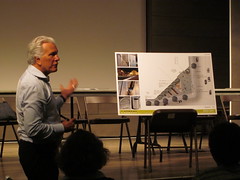 Meghan Keneally Thomas Balsley at Monday’s meeting.
Meghan Keneally Thomas Balsley at Monday’s meeting.Members of Community Board 3 voted unanimously Monday night to oppose plans for an outdoor plaza at the new 51 Astor Place because of questions about whether the design provides enough space for the public and fits aesthetically with the surrounding neighborhood.
The board’s Planning and Land Use committee said that it will not endorse the plaza project unless changes are made that take into account the historic nature of the area around 51 Astor and other design issues, including the placement of benches.
Work is set to begin in the next few days, and the construction of the mixed-use commercial tower is set to last for 17 months.
After listening to a presentation by Thomas Balsley, the designer in charge of planning the outdoor space that will accompany the new building on Astor Place, members of the public were given a chance to address the board.
Speakers, many of whom were opposed to the design, raised a range of issues about the project from its look and aesthetics to what some said was its failure to account for the historic nature of the district.
“It’s like it’s from some other city,” said Marilyn Appleberg, who was a part of the group that discussed the initial plans for the building when they were approved in 2002. “I was really disappointed.”
A final discussion on the plaza project will occur at the full community board meeting on July 26.
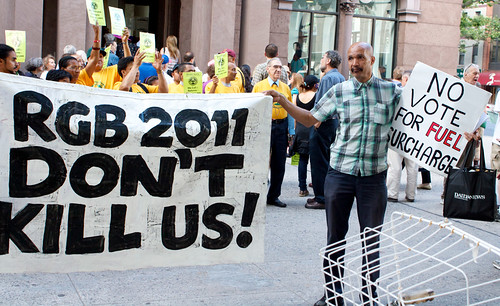 Khristopher J. Brooks Demonstrators calling for a freeze on rent increases this year gathered outside Cooper Union before tonight’s vote.
Khristopher J. Brooks Demonstrators calling for a freeze on rent increases this year gathered outside Cooper Union before tonight’s vote.Rent prices across the city will increase 3.75 percent for tenants signing a one-year lease and 7.25 percent for tenants signing a two-year lease.
Members of the Rent Guidelines Board passed the increases by a vote of 5-4 Monday night during a meeting in Cooper Union’s Great Hall. The vote came at the conclusion of a raucous meeting during which dozens of demonstrators — many of whom chanted and held placards — called for a freeze on increases this year.
The increases, which apply only to rent stabilized apartments and lofts, take effect Oct. 1 and last until Sept. 30, 2012.
Based on the $1,700 a month average for studio apartments in the East Village, the increases approved by the board tonight translate into an average of $63.75 for one-year leases and $123.25 for two year leases. For tenants living in a one-bedroom, where the East Village averages $2,500 a month in rent, the average increases are $93.75 for one-year leases and $181.25 for two-year leases. Housing activists said after the vote that the negotiations preceding tonight’s meeting were slanted in favor of landlords.
An hour before the vote, scores of people gathered outside the Great Hall. Many of those in attendance had taken part in a rally organized by Tenants and Neighbors earlier in the afternoon.
Read more…
John Vaccaro, who lives above Mars Bar, has made peace with its imminent closing – and the loss of his home – and is prepared to move on.
When John Vaccaro’s loft is torn down this August he will not be sad. When asked what he will miss, “Absolutely nothing,” is his immediate response.
Mr. Vaccaro is one of four tenants, in addition to the Mars Bar and Joe’s Locksmith, being pushed out of 11-17 Second Avenue this summer as the building’s owner, BFC Partners, moves ahead with plans to build a luxury high-rise.
Mr. Vaccaro came to New York in 1961 and enjoyed a successful career as a theater director. Back then, he says, “We all knew each other,” referring to the artists and musicians — Andy Warhol among them — that roamed the East Village in its bohemian heyday.
Now, looking down from his fire escape just above Second Avenue, Mr. Vaccaro says that those days are gone.
“Who are these people down there?” he protests. “I don’t know any of them.”
Read more…
Dozens of chanting New Yorkers marched through the East Village Monday afternoon trying to gather more voices to oppose anticipated rent increases in New York City.
The march — which started at the corner of 14th Street and First Avenue, snaked through the neighborhood and ended at Cooper Union’s Great Hall — took place as the Rent Guidelines Board was receiving an earful of public testimonies. Board members will decide next Monday if, or how much, rent prices will be increased starting Oct. 1 and ending Sept. 30, 2012. The decision will affect tenants in rent stabilized apartments and lofts.
As the marchers turned corners and crossed streets, participants waved makeshift signs, pumped their fists and yelled, “The tenants, united, will never be defeated!”
After the march, city council members Daniel R. Garodnick and Rosie Mendez chanted with the crowd and urged the marchers to go inside Cooper Union and testify about why the guidelines board should not increase rent prices.
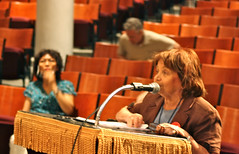 Khristopher J. Brooks Adele Bender during today’s hearing.
Khristopher J. Brooks Adele Bender during today’s hearing.Adele Bender is a quiet woman with short red hair who lives in a rent-stabilized apartment in Forest Hills, Queens.
The 80-year-old widow took an hour-long trip to the East Village this morning to tell the Rent Guidelines Board how she and her neighbors cannot afford to pay higher rent.
“I’m here for the concerns of senior citizens,” Ms. Bender said. “Social Security has not been increased, but rent has gone up. I have a friend, I can tell you right now, who gets $1,400 in Social Security a month and she has to pay for expensive drugs. Her pills are several hundred dollars. Look, I know we’re here talking about housing and not health, but most times they are connected.”
Ms. Bender and several other New York City residents have piled into Cooper Union’s Great Hall today hoping to convince board members not to increase rent prices this year.
More than 100 people from across the city have pre-registered to address board members and even more New Yorkers will arrive later today to speak to board members informally.
Read more…
 Tim Schreier
Tim SchreierEast Villagers, Monday is your last chance to publicly address the Rent Guidelines Board before board members vote on rent increases.
The board held a public testimony session yesterday at the New York City College of Technology in Brooklyn. Board members will hold their final testimony session starting at 10 a.m. Monday inside Cooper Union’s Great Hall. Board members will listen to testimonies throughout the day and into the evening.
To the dismay of many East Villagers, the board took a preliminary vote last month to increase rent prices from 3 percent to 5.75 percent for tenants signing one-year apartment leases and from 6 percent to 9 percent for those inking a two-year lease.
Andrew McLaughlin, the board’s executive director, said Friday it’s tough to determine how much the public testimonies will impact the board’s final decision on increases.
“It’s certainly an important part of the process,” Mr. McLaughlin said. “It gives the board an opportunity to hear from the public, but the amount the testimonies impact the actual vote depends really on each individual board member.”
If you would like to speak during the public testimony session, arrive at the Great Hall before 6 p.m. and register with a board official.
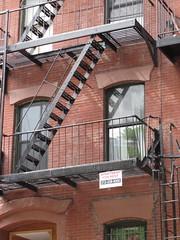 Meghan Keneally One of the few available rentals.
Meghan Keneally One of the few available rentals.When scouring apartment listings, it always seems like that time — that particular time when you decided to move — was the worst possible choice because there are so few apartments available. For those searching now, they’re not just imagining it.
The percentage of available apartments in Manhattan this May hit its lowest rate in the past five years. With every neighborhood differing slightly, the East Village average was 0.69 percent — the same as the city wide average — and the overall city vacancy rate decreasing by 0.25 percent from the month prior.
According to StreetEasy, a real estate comparison website, the overall amount of rental apartments in Manhattan is down by 18 percent from this time last year.
“Rental inventory is tight everywhere right now. It’s the season: May, June, and July are the peak months for rental,” said Sofia Song, vice president of research at StreetEasy.
The East Village is known largely in the real estate world for being filled with college students and recent grads (along with the artists and musicians who shaped the area’s identity), and while they do still make up a sizable amount of the market, there are other groups interested in the area.
Read more…
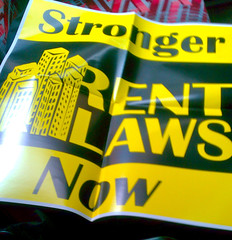 Khristopher J. Brooks A sign created by advocates for new rent laws.
Khristopher J. Brooks A sign created by advocates for new rent laws.As the hours tick by and criticism mounts, state lawmakers have not settled on a renewal plan for New York City rent laws.
Legislators in Albany allowed the law to expire Wednesday night and they’re now in extra innings trying to develop a solution that satisfies both Assembly Democrats and Senate Republicans. Gov. Andrew M. Cuomo has said that he wants the law renewed in some form before the 2011 legislative session ends Monday.
Meanwhile, local tenants and tenant advocacy groups in our neighborhood are anxious to find out what will happen. They’re constantly checking news Web sites, e-mailing their contacts in the Capitol and taking their protest efforts to a higher level. Here’s some local reaction to the deliberations in Albany.
Steve Herrick
Executive Director
Cooper Square Committee
“I think it’s not surprising that it’s come down to the wire again because the Republicans have the majority in the Senate and so they have a little more leeway there, but luckily we have Gov. Cuomo on our side. Tenants are going to continue calling Cuomo and telling him they appreciate what he’s doing, but he has to continue to apply some pressure.”
Read more…
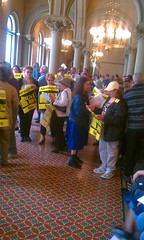 Khristopher J. Brooks Protesters at the rally.
Khristopher J. Brooks Protesters at the rally.ALBANY — Hundreds of New York City residents, including 33 from the East Village, converged on the state Capitol Building Monday trying to urge state lawmakers to renew and tweak the laws that govern apartment rent prices.
Leaders of the Cooper Square Committee, Real Rent Reform and Good Old Lower East Side, organized the rally, which muscled its way into the building, past legislators, up steps and eventually to the office of Gov. Andrew M. Cuomo.
Shouting “Fight! Fight! Fight! Housing is right!” the rally participants started on the fourth floor and then moved to whichever other corridor could accommodate them. They made noise, blew whistles, waved posters, banged on doors and clogged hallways.
“Right now, in Albany, our presence and our demands are being heard more than ever, more than I can ever remember,” said Wasim Lone, housing services director for Good Old Lower East Side.
At issue is how and at what rate landlords should be allowed to raise rent in future years. In its current form, the rent laws allow New York City landlords to dramatically increase the rent of a property immediately after a tenant has moved out. This practice, known as “vacancy decontrol” has resulted in roughly 300,000 empty rental units across New York City, said Marina Metalios, 48, a volunteer with Real Rent Reform.
Read more…
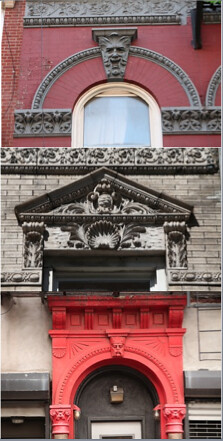 David Jarrett Details from a few of the buildings that would gain protection under the revised historic district plan.
David Jarrett Details from a few of the buildings that would gain protection under the revised historic district plan.The effort to grant historic landmark status to parts of East Village recently received an unexpected boost.
In an apparent response to residents’ concerns, the city has decided to expand a proposed historic district to include an additional block.
The district, which was originally designed to encompass broad swaths of properties along Second Avenue and on 10th Street, now also includes Second Street between First and Second Avenues, as well as new buildings at the corner of Sixth Street and Avenue A.
“The buildings were almost crying out to be included in the district,” said Richard Moses, a member of the Lower East Side Preservation Initiative. “It makes sense to include them, they’re very strong architecturally, and there is a lot of cohesion in the streetscape.”
The decision by the Landmarks Preservation Commission to add the buildings came as State Senator Tom Duane endorsed preservationists’ push for the expanded district.
“Many other buildings not far outside the study areas have architectural, cultural and historic significance and, with neighboring structures, a cumulative ‘sense of place,’ which makes them worthy of consideration,” Mr. Duane wrote in a letter to the commission earlier this month.
If approved, the landmark designation would essentially preserve buildings within the district. Property owners would have to win approval from the commission before making changes to the exterior of their buildings.
Read more…
 Mark Riffee Anne Guiney.
Mark Riffee Anne Guiney.It would be a gross understatement to say that the East Village is in the midst of a transition. Old buildings have been threatened and new ones are scheduled to rise, much to the chagrin of many locals. But as Bill Millard, an East Village resident and freelance writer for various architectural and urban design publications, points out in an e-mail, it’s just as “important to consider ways to encourage the types of development that provide or foster benefits for a neighborhood” as it is to protest and block “destructive forms of development.”
So what kind of development is positive and why, recently, have some seemingly less favorable projects been allowed to continue in the East Village? The Local caught up with Anne Guiney, executive director of the Institute for Urban Design, and asked for her thoughts.
Q.
What architectural elements characterized the East Village before the gentrification of the neighborhood?
A.
It all depends on what your carbon dating system is for gentrification and how you define it. I think the East Village has, for a very long time, been defined by tenements in terms of building type. And that hasn’t changed a lot architecturally. Obviously the street-level retail and the kinds of uses are a lot more commercial, a lot more recreational than they were 20 or 30 years ago, but the physical structure of the buildings is still defined by the tenement.
Read more…
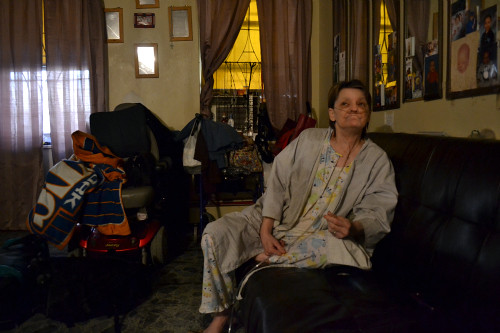 Ian Duncan Ruth Christie at home in her Lower East Side II apartment. Residents of the public housing project complain of damaged facilities and strong smells of sewage.
Ian Duncan Ruth Christie at home in her Lower East Side II apartment. Residents of the public housing project complain of damaged facilities and strong smells of sewage.Ruth Christie was staying in wearing her pajamas and watching movies on VHS. She finds it hard to go out as she must constantly be attached to her oxygen tank to deal with her emphysema.
She has a motorized wheelchair but struggles to maneuver it out of her cramped apartment by herself. “Walking does a number on my breathing,” Ms. Christie, who is 59, said.
Ms. Christie said her condition worsened after she moved to Lower East Side II eight years ago. Residents of LES II complain of dark brown water coming from their taps. When washing machines are running, wastewater finds its way into the pipes, they say.
Residents also complain of intermittent heat and a smell of sewage. As early as February this year the smell was strong and according to Ms. Christie it gets worse most summers.
The Obama Administration turned on the stimulus tap just over two years ago, dedicating funds to improving the quality of public housing. $423 million was given to New York City to fix up its projects. Housing and Urban Development Secretary Shaun Donovan chose the Rutgers Houses on the Lower East Side to announce the New York package in March 2010. “It’s probably the most significant preservation action in the history of public housing,” he said at the time.
Of the total, $1 million reached LES II and was invested in roof repairs. That work was completed last fall. The problem is that what the project probably needs is a new plumbing system, Marquis Jenkins, then a community organizer at Good Old Lower East Side, told the Local in February.
Read more…
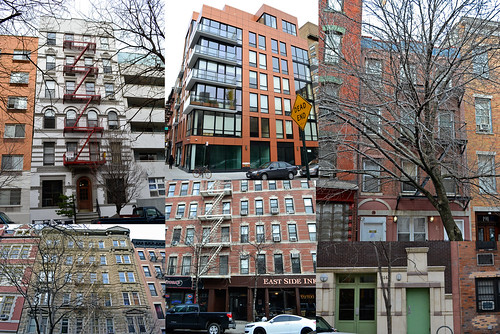 Photo illustration by Mark Riffee Six buildings with apartments for sale in the East Village.
Photo illustration by Mark Riffee Six buildings with apartments for sale in the East Village.It’s fun to gawk at the $3 million lofts and $4 million townhouses in Curbed’s Marketplacelistings for the East Village. Most of us can’t do much more than gawk at these palatial 3,500-square-footers unless we’re feeling very ambitious and chance a pipe dream while lying in our beds — which are conveniently five steps from the kitchen, bath, and front door in our 450-square-foot studios — wondering if today is a hot-water day or no-hot-water day.
But maybe someday we will be able to afford a less garish apartment with a more reasonable price tag. In fact, if you have the money now or in the next few years, you may want to think about making a move sooner than later. According to Tara-Nicholle Nelson, consumer educator for Trulia.com, a real estate search engine company and research group, prices and interest rates are extremely low right now and qualifying for loans will become more difficult in coming years.
We at The Local asked Ms. Nelson for a status update on the East Village market and some expert advice on buying and selling.
Q.
How has the East Village market evolved recently?
A.
In terms of price, we’ve seen value increase over this past year. On a price per square footage basis, there’s been a 26.5 percent year-over-year increase to $1,087 per square foot from $798 per square foot.
Read more…
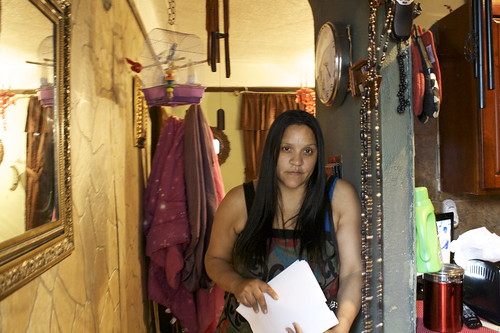 Rachel OhmJanette Brown holds a copy of the letter she and six other residents sent to the state Attorney General in an effort to fight against the purchase of 390 East Eighth Street, a low-income housing building, by Tower Brokerage.
Rachel OhmJanette Brown holds a copy of the letter she and six other residents sent to the state Attorney General in an effort to fight against the purchase of 390 East Eighth Street, a low-income housing building, by Tower Brokerage.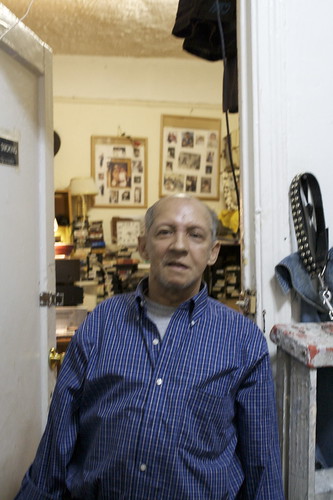 Carlos Baez has been a resident of 390 East Eighth Street for over 30 years. Rachel Ohm
Carlos Baez has been a resident of 390 East Eighth Street for over 30 years. Rachel OhmFor 36 years Carlos Baez, 63, has called 390 East Eighth Street home. The two bedroom apartment that he shares with his niece on the first floor of the building holds his large collection of VCR tapes, which includes every Whoopi Goldberg and Charles Bronson movie ever made. Because he used to be the super of the building, Baez’s apartment is bigger than most and is conveniently located on the first floor, the perfect spot because his 14-year-old dog, Little, has arthritis and can barely walk up stairs.
And yet he’s thinking of moving.
On Feb. 25, 390 East Eighth Street, a dedicated low-income housing building, was sold to Tower Brokerage, an East Village real estate developer with plans to put in market-rate apartments.
The HDFC, the tenant-owned and operated corporation that currently owns the building, finally conceded to the sale seeing no way out from a financial debt that accumulated during the years the building was being run by a non-profit called Interfaith Adopt-a-Building.
The building “owes the city about $1.2 million in water bills and taxes,” said Robert Perl, president of Tower Brokerage. “This sale is the only way to pay the city funds.”
Read more…
 Design by Andrew and Nicholas Hunt The Local asked neighborhood designers for their vision of how a vacant lot of East 13th Street (below) might be transformed. Above is the design by architects Andrew and Nicholas Hunt, whose plan includes a farmers market, community garden space, a restaurant and residential units.
Design by Andrew and Nicholas Hunt The Local asked neighborhood designers for their vision of how a vacant lot of East 13th Street (below) might be transformed. Above is the design by architects Andrew and Nicholas Hunt, whose plan includes a farmers market, community garden space, a restaurant and residential units.  Rachel Trobman
Rachel TrobmanOver the past 40 years, the lot on 13th Street east of Third Avenue has been many things: a home for stray animals, a showcase for street artists, a resting place for the homeless, a dumping ground for clothes.
But one thing it has never been is developed.
And, according to land owner Builtgross Associates, a subsidiary of Milstein Properties, that’s not going to change in the near future as no solid plans are in the works.
“We’re examining several alternatives but haven’t formalized anything yet,” said Anthony Bergamo, vice chairman of executive planning for Milstein Properties. “We’re looking for something that would be good for the community and area businesses.”
For many years, the massive, 23,000-square-foot site, which stretches to 14th Street and is formally known to the city as Lot 15 on Block 469, did serve the community. It was once B.F. Keith’s vaudeville theater and then, later, a single-screen movie called the RKO Jefferson. While it closed in the 1970s, the building’s shell was not demolished until late 1999. It has remained vacant ever since.
Read more…
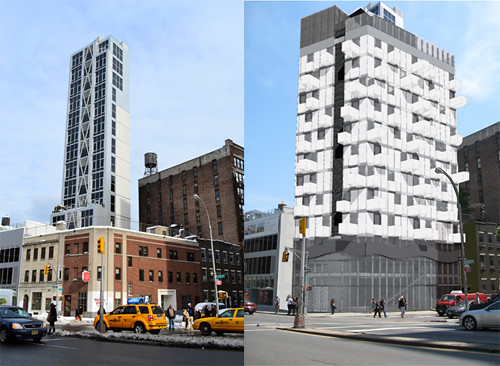 Courtesy of Gene Kaufman Architect The Salvation Army building at the corner of Bowery and East Third Street. Right: A rendering of what the corner will look like when Gene Kaufman’s Bowery boutique hotel is completed.
Courtesy of Gene Kaufman Architect The Salvation Army building at the corner of Bowery and East Third Street. Right: A rendering of what the corner will look like when Gene Kaufman’s Bowery boutique hotel is completed.Much has been said about the design for the new boutique hotel and restaurant that is expected to take the place of the vacant Salvation Army building on the corner of the Bowery and East Third Street.
Several local blogosphere commentators have made it clear that this addition is not welcome in their neighborhood. Andrew Berman, executive director of the Greenwich Village Society for Historic Preservation, jokingly referred to the 11-story, 72-room hotel as the “red tumor building” in reference to a series of asymmetric balconies that will protrude from the building and glow red at night.
“It’s totally inappropriate and I think it will be another unfortunate, unwanted intrusion into the Bowery,” said Mr. Berman. “The scale is wrong, the design is wrong. It almost seems designed to offend.”
Gene Kaufman, the architect hired by the Paris-based Louzon Group to design the hotel and restaurant, is aware of the East Village’s reaction to the renderings published by The New York Observer last month, but is hoping it might not be permanent.
“The neighborhood sentiment in the beginning is the start of a process,” said Mr. Kaufman, who has designed other controversial hotels in New York. “It’s not necessarily reflective of what’s going to happen in the long term.”
Read more…
The entry of 2 Cooper Square onto the East Village real estate scene has been well-chronicled, from its high-profile residents to the renovation of the landmarked Skidmore House next door.
Recently, The Local spoke with residents of the luxury high-rise about life in one of the neighborhood’s newest – and priciest – addresses, which has a gym and screening room in the basement lounge as well as a much blogged-about rooftop pool.
Residents say the building’s amenities are top-notch. For some, though, the prime East Village location is perhaps busier than they had expected. One resident cites disturbances from an ongoing construction project on Fourth Street, which impacts residents in Southern-facing units; she also says that noise from the nearby nightspot Bowery Bar keeps her up at night.
NYU Journalism’s Stephanie Butnick reports.
Comprehensive real estate information about the East Village is available at the following links:
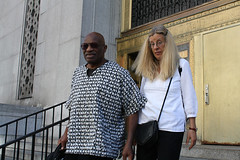 Maya Millett Trudy Silver and Bruce Morris, owners of the 5C Cultural Center, at State Supreme Court earlier today.
Maya Millett Trudy Silver and Bruce Morris, owners of the 5C Cultural Center, at State Supreme Court earlier today.A State Supreme Court justice today postponed the eviction of a nonprofit East Village arts center, which has been locked in a dispute with its co-op board for the past 15 years.
The disagreement, between the 5C Cultural Center, a nonprofit devoted to promoting jazz and the arts, and the co-op board at 702 East Fifth Street, revolves around whether the center broke a series of lease agreements regarding building repairs and music performances.
The board initiated eviction proceedings in April but earlier today Justice Saliann Scarpulla asked the two sides to try to negotiate a settlement out of court before moving forward with the eviction process.
Read more…
 Ian Duncan The site BFC will develop, 11-17 Second Avenue – the current home of Mars Bar – is squeezed in among the much larger Avalon Bowery Place development
Ian Duncan The site BFC will develop, 11-17 Second Avenue – the current home of Mars Bar – is squeezed in among the much larger Avalon Bowery Place development



















